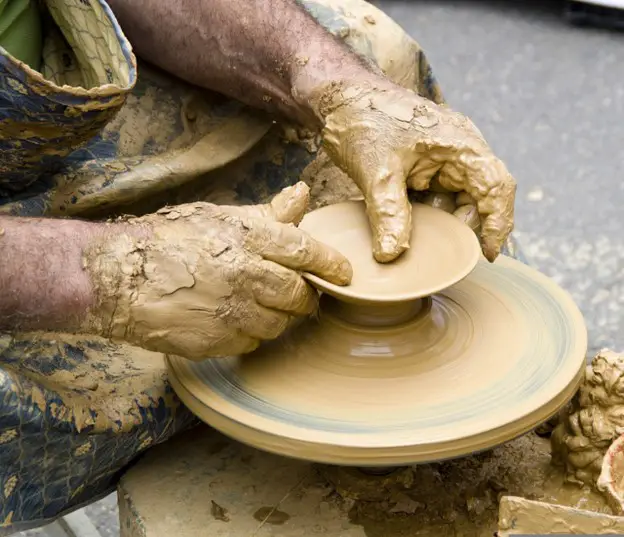Clay and other varieties of inelastic earth are created as a consequence of the disintegration of rocks with extremely small particle sizes. Clay may be found in a wide variety of forms. There are many different types of pottery clay, and each type can be distinguished from the others due to the presence of a specific set of clay minerals. These clay minerals each contain a different set of metal oxides and organic components, so each type of pottery clay has its distinct composition. By reading this, you will learn more about the properties of clay as well as the many available different types of clay.
Types of Clay
Clay may be separated into a few distinct classes based on its qualities as well as the temperature at which it has to be burned for the clay to “grow,” which means achieving its maximum degree of hardness and durability.
The most common kinds of clay bodies include earthenware clay bodies, stoneware clay bodies that are used for mid-fire, and stoneware clay bodies that are used for high-fire. All three may be obtained from a variety of commercial vendors in a condition that is moist and ready to be used. It is also feasible to manufacture clay bodies by blending dry clays and additives with water to produce the clay body that is most suited to the requirements that you have specified.
Clay’s Pliability
Clay is differentiated from inelastic earth and fine sand by its ability, after being wetted with the necessary amount of water, to form a cohesive mass and to maintain its shape after being molded. Fine sand and inelastic earth, on the other hand, do not possess this ability. Clay is distinguished from both of these forms of soil by its capacity to be shaped. Clay is famous for its plasticity, which accurately characterizes the quality of the material. When heated to high temperatures, clay goes through a process of partial melting, which results in the hard, brittle, rock-like solid that is known as a ceramic substance.
Stoneware
Stoneware clays tend to be more malleable than other types of clay and might become a grayish tint when wet. The process of firing produces colors that range from light grey and buff to medium grey and brown, depending on the intensity of the heat. The colors that are achieved by burning ceramics are strongly influenced by the particular procedure that is used.
Clay bodies used in the production of stoneware that is fired at temperatures between 2150 and 2260 degrees Fahrenheit are intended to mature at these temperatures (1160 C and 1225 C). Clay bodies used in the production of high-fire stoneware are subjected to temperatures ranging from 2200 to 2336 degrees Fahrenheit during the process that produces their mature hardness (1200 C and 1300 C).
Earthenware
Earthenware clays are among the earliest forms of clays that have been used by potters, and nowadays, earthenware clay is the type of clay that is most often encountered. Clays of this kind have a high degree of plasticity, which translates to ease of manipulation; also, they may be sticky. Because earthenware clays contain iron and other mineral impurities, they can reach their optimal level of hardness at temperatures that are lower than those required for other types of clays, specifically between 1745 and 2012 degrees Fahrenheit. This allows earthenware clays to be used in a wider variety of applications (950 C and 1100 C).
The colors red, orange, yellow, and light gray are the ones that show up most often in earthenware clays when they are moist. Burnt earthenware may have a variety of hues, including brown, red, orange, buff, medium grey, and white. Some of these colors are more common than others. The colors of finished ceramics are primarily determined by many major elements, the most important of which are the number of mineral impurities present and the kind of burning utilized. Terracotta, which means “baked earth,” is one of the most popular types of earthenware. It is also one of the oldest types of pottery.
Ball Clay
Ball clays are characterized by their high plasticity and often include relatively few mineral impurities in their makeup. They achieve their fully developed level of brittleness at a temperature of around 2336 degrees Fahrenheit, which is roughly the same in Celsius (1300 C). After being fired, they change to a hue that is somewhere between a light grey and a light buff from their dark grey look while they are wet.
Utilizing ball clay comes with several important drawbacks that should be considered. The drying and fire procedures cause them to experience a significant degree of shrinkage, which renders them useless on their own and prevents them from being helpful. They are, however, of considerable utility when blended with other clays to increase the final product’s workability and plasticity and make it easier to manipulate.
Fire Clays
The characteristics of different types of fire clay may vary widely from one another. Their vast firing range is one of their most distinguishing features. Around 2696 degrees Fahrenheit is the temperature at which they achieve maturity (1500 C). Although they have a low percentage of mineral impurities, they often include iron inclusions, which, when heated, give the illusion of having spots on them.
The addition of fire clays to stoneware clay bodies is a common practice that serves two purposes: it raises the temperature at which the clays mature and it provides the burned clay with an additional degree of abrasion, also known as “tooth.” Both of these goals are accomplished by increasing the temperature at which the clays mature. In addition to this, fuel-fired kilns make use of them to construct cone packs, which monitor temperature, as door seals, as supports for ware or shelves, and so on.







